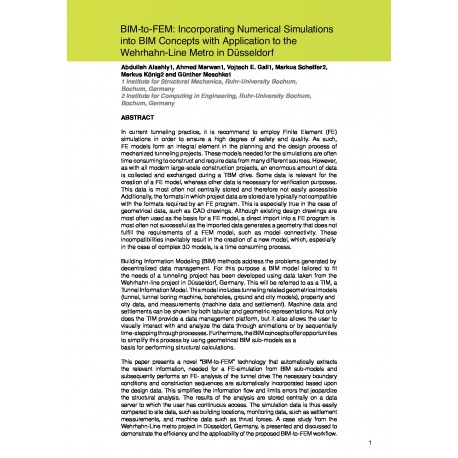Cart
0
0
No document
0,00 €
Total
Document successfully added to your shopping cart
Quantity
Total
There are 0 items in your cart.
There is 1 item in your cart.
Total documents
Total shipping
To be determined
Total
Search & filter
Search for a publication
Search & filter

BIM-to-FEM: Incorporating Numerical Simulations into BIM Concepts with Application to the Wehrhahn-Line Metro in Düsseldorf
901_bim_to_fem__incorporating_nu
M. Scheffer / A. Alsahly / G. Meschke / V. E. Gall / A. Marwan / M. König
In current tunneling practice, it is recommend to employ Finite Element (FE) simulations in order to ensure a high degree of safety and quality. As such, FE models form an integral element in the planning and the design process of mechanized tunneling projects. These models needed for the simulations are oftentime consuming to construct and require data from many different sources. However,as with all modern large-scale construction projects, an enormous amount of datais collected and exchanged during a TBM drive. Some data is relevant for the creation of a FE model, whereas other data is necessary for verification purposes. This data is most often not centrally stored and therefore not easily accessible Additionally, the formats in which project data are stored are typically not compatiblewith the formats required by an FE program. This is especially true in the case of geometrical data, such as CAD drawings. Although existing design drawings are most often used as the basis for a FE model, a direct import into a FE program ismost often not successful as the imported data generates a geometry that does notfulfill the requirements of a FEM model, such as model connectivity. These incompatibilities inevitably result in the creation of a new model, which, especiallyin the case of complex 3D models, is a time consuming process.Building Information Modeling (BIM) methods address the problems generated bydecentralized data management. For this purpose a BIM model tailored to fit the needs of a tunneling project has been developed using data taken from the Wehrhahn-line project in Düsseldorf, Germany. This will be referred to as a TIM, aTunnel Information Model. This model includes tunneling related geometrical models (tunnel, tunnel boring machine, boreholes, ground and city models), property andcity data, and measurements (machine data and settlement). Machine data and settlements can be shown by both tabular and geometric representations. Not onlydoes the TIM provide a data management platform, but it also allows the user to visually interact with and analyze the data through animations or by sequentially time-stepping through processes. Furthermore, the BIM concepts offer opportunities to simplify this process by using geometrical BIM sub-models as abasis for performing structural calculations.This paper presents a novel “BIM-to-FEM” technology that automatically extracts the relevant information, needed for a FE-simulation from BIM sub-models and subsequently performs an FE- analysis of the tunnel drive The necessary boundary conditions and construction sequences are automatically incorporated based upon the design data. This simplifies the information flow and limits errors that jeopardize the structural analysis. The results of the analysis are stored centrally on a data server to which the user has continuous access.


